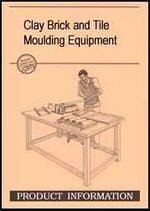TERSTARAM (manual) and semi-terstamatique (motorized)[edit | edit source]
Brick and Tile Presses
Manufacturer
APPRO-TECHNO
24, rue de la Rieze
B-5660 Couvin (Cul-des Sarts)
Belgium
Tel. [..32] 60 - 37 76 71
Tlx. 51622 ap tec b
Fax. [..32] 60 - 37 78 87
Description
The TERSTARAM press is based on the design of "La Medelon", the famous Belgian machine developed at the beginning of the 20th century, which was later successfully manufactured under the names "Stabibloc" and "Landcrete" in different parts of the world. These machines were designed to produce compressed bricks for firing, while the TERSTARAM press is now also well-known as a block press for making unfired compressed earth blocks.
The main advantages of the design are the robust construction, the possibility of using various types of moulds, which take just 15 minutes to change; the mobility of the machine, which can easily be moved by two men; end the good compaction of the bricks, exerting an exceptionally high pressure for a manually operated press with mechanical energy transmission. A recent improvement is the automatic unlocking of the cover and ejection of the compressed bricks.
The TERSTARAM is available in two versions: the standard version with a maximum product size of 29.5 x 14 x 9 cm, and the special version with a broader frame and maximum product size of 40 x 20 x 10 cm.
The SEMI-TERSTAMATIQUE machine is a completely revised version of the "La Majo" press. The machine is a motorized press, supplied either with a 3 hp electric motor or 5 hp diesel engine. An oversized car clutch controls and drives the press.
The machine is designed to withstand intensive and rough use, even under critical climatic conditions, and is easy to maintain with a few tools. A powerful spring in thrust system protects the press against poor quality clays or overfilling of moulds.
Various types of bricks and paving tiles (for air-drying or for firing) can be produced, but no roofing tiles, because the compression is too quick to allow the air to escape from the clay. Special moulds can be made to order up to a maximum size of 40 x 20 x 10 cm. The SEMI-TERSTAMATIQUE is supplied with narrow tables on either side of the mould to facilitate filling the mould and removing the finished products.
|
TERSTARAM Standard (ST) and Special(SP) |
SEMI-TERSTAMATIQUE | |
|
Size of machine (length x width x height) |
ST 135 x 70 x 90 cm (53 x 28 x 35 in) |
220 x 65 x 110 cm (87 x 26 x 16 in) |
|
SP 135 x 80 x 90 cm (53 x 32 x 35 in) | ||
|
Weight of machine (with mould / without mould) |
ST 360/320 kg |
880/840 kg |
|
SP 400 / 360 kg | ||
|
Size of crate for shipment |
ST 150x 55 x 102 cm (59 x 22x 40 in) |
227x75 x 112 cm (90 x 30 x 18 in) |
|
SP 150 x 65 x 102 cm (59 x 26 x 40 in) | ||
|
Weight of packed machine |
ST / SP 550/590 kg |
1000 kg |
|
Maximum product dimensions |
ST 29.5 x 14 x 9 cm (11.6 x 5.5 x 3.5 in) |
40 x 20 x 10 cm (16 x 8 x 4 in) |
|
SP 40 x 20 x 10 cm (16 x 8 x 4 in) | ||
|
Energy input / transmission |
manual / mechanical |
motorized / mechanical |
|
Practical production capacity |
1400 bricks / day |
1700 - 3400 bricks I day |
|
Labour force required |
3 - 5 workers |
3 - 5 workers |
|
Price (ex works) |
ST without mould 49500 FB(» 1 400 US0 |
with electric motor347000 FB(» 9900 US0 |
|
valid June 1991 |
SP without mould 53300 FB(» 1530 US0 |
with diesel engine 374000 FB (» 10700US0 |
|
Double brick mould 8820 FB (» 250 US0 |
Spare parts kit 23600 FB (» 680 US0´ | |
|
FB = Belgian Francs |
Flemish tile mould 14700 FB(» 420 US0 | |
|
Mangalore tile mould 16200 FB(» 460 US0 | ||
|
Spare parts kit 5300 FB(» 1 50 US0 | ||
